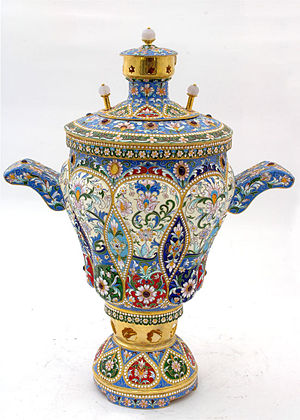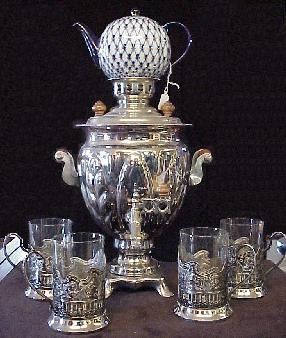The History of Samovars
Written by Vadim on April 13, 2011 – 7:02 pm -
Sharing tea with family and guests is a huge part of Russian culture, making samovars an irreplaceable part of the Russian home. They may come in a variety of shapes and are usually made to be decorative as well, with painting, gilding, and Russian folk designs. The samovar is usually kept in the common area of the home for easy access and their high decorative value.
The traditional samovar is a metal container heated by coal, charcoal or other fuels such as dried pinecones. However, many modern samovars are electric and work similar to a commercial water heater. Because they are usually used for tea, many models include an attachment that can hold a teapot with tea concentrate.
A samovar typically has a body (the urn where the water is kept), a base and chimney, a vented cover, and a faucet. In addition, the top is often made to hold a teapot. The fire under a samovar was generally kept smoldering at all times, with fuel being added and the flames stoked with a bellows when the water was to be heated.
No one knows when the samovar was invented, but they are shown in a variety of classic Russian art. We do know that they have been used since ancient times; an archaeological dig in Azerbaijan unearthed a samovar that was about 3,600 years old. The oldest samovar that is still in usable condition hails from 1717 and is owned by a samovar collector. Ancient samovars are loved by collectors for their durability and charm.

The first known samovar factory was opened in Tula, Russia in 1778 by Ivan Fyodorovitch and Naar Fyodorovitch Lisitsyn. These samovars were so durable and beautiful that many are still in use today and known for their traditional Russian beauty. The mass production of samovars ensured that even peasants could afford them, and they were soon an irreplaceable part of Russian culture. However, handmade models of higher quality continued to be favored in upper class homes. In fact, there is a Russian expression that translates as “to have a sit by the samovar” and means to have a friendly discussion over tea.
In modern times, the samovar is associated with the exotic traditional cultures of both Russia and the Middle East. Samovars are still found in common use in these areas as well as other places over the globe with heavy Eastern European or Iranian populations.

Samovars may come in different shapes and sizes, but they are almost always made of metal. Depending on the budget of the owner, this metal may be a cheaper material such as tin or nickel or a more expensive one such as copper, polished brass, silver or gold. Regardless of the material, samovars are made to be both beautiful and functional.
Tags: kettle, samovar, tea, teaware
Posted in General | No Comments »




You must be logged in to post a comment.